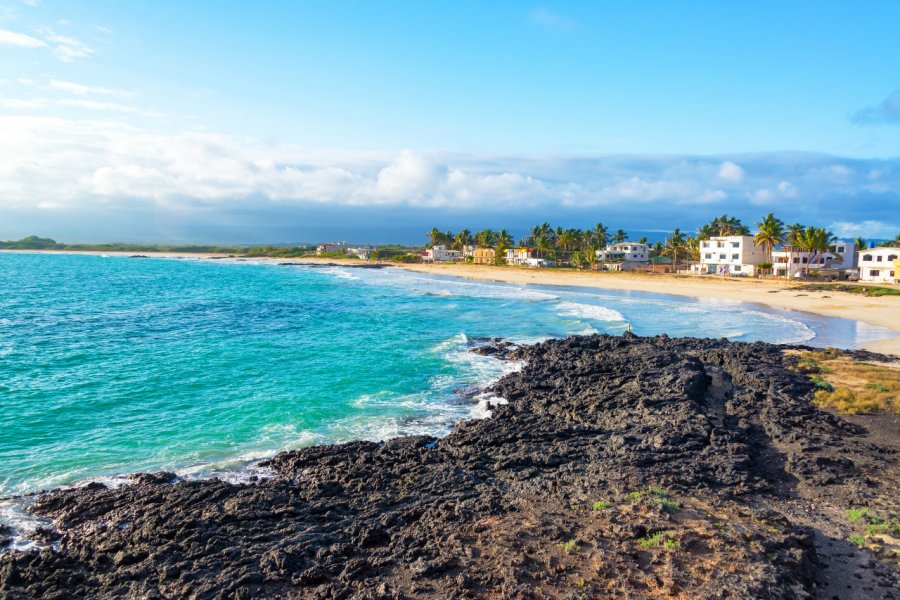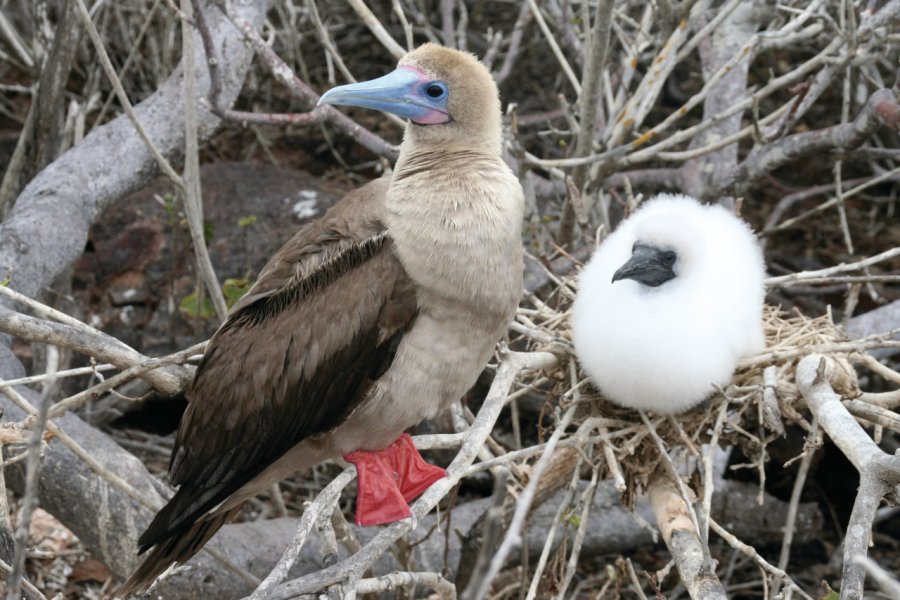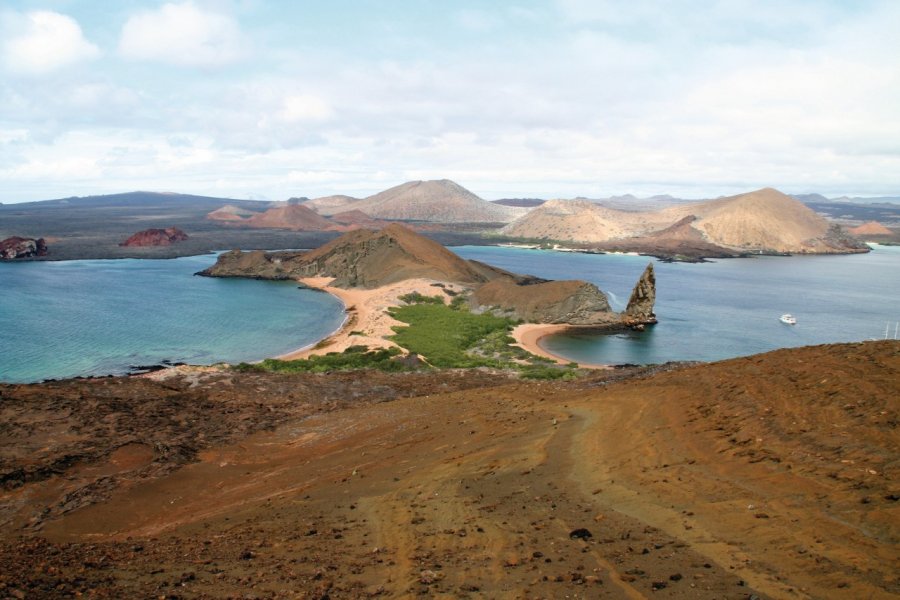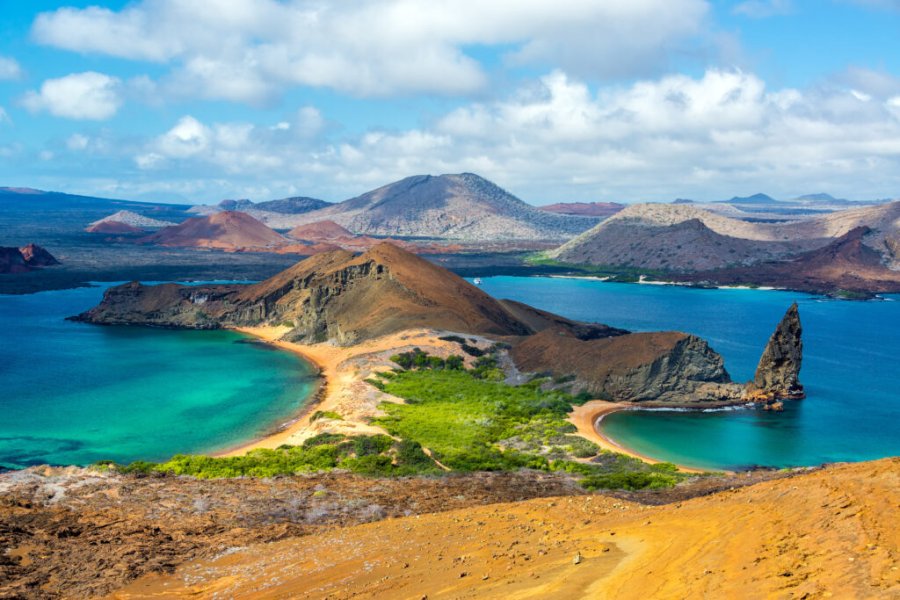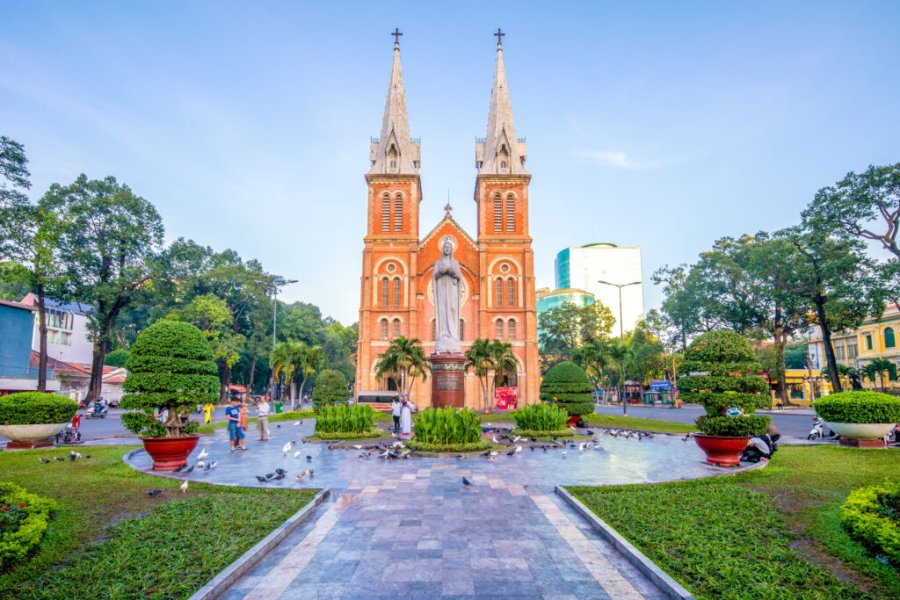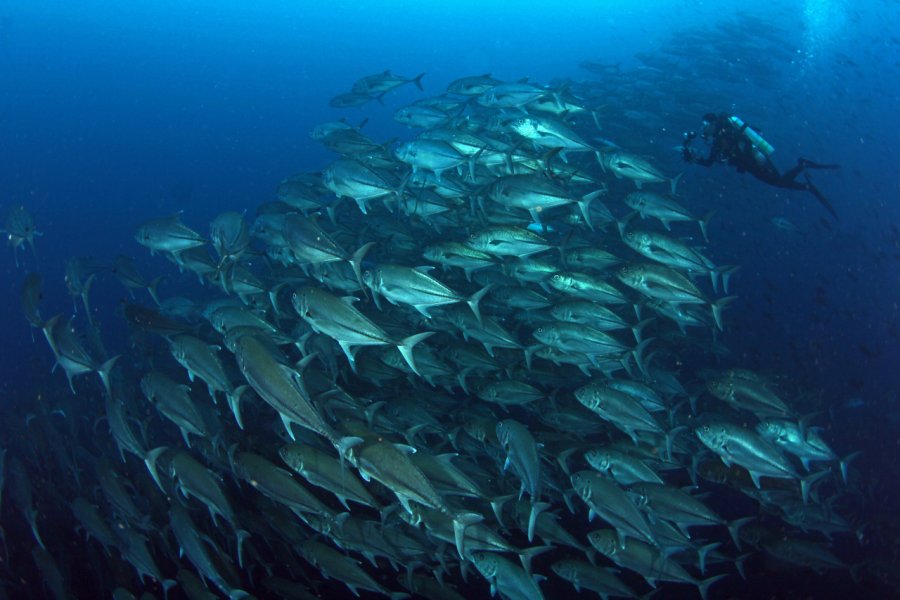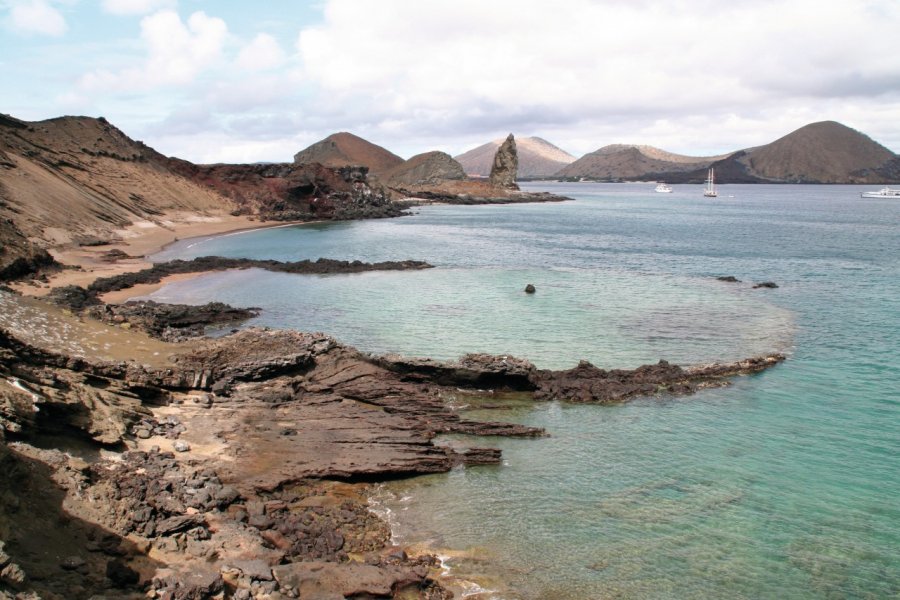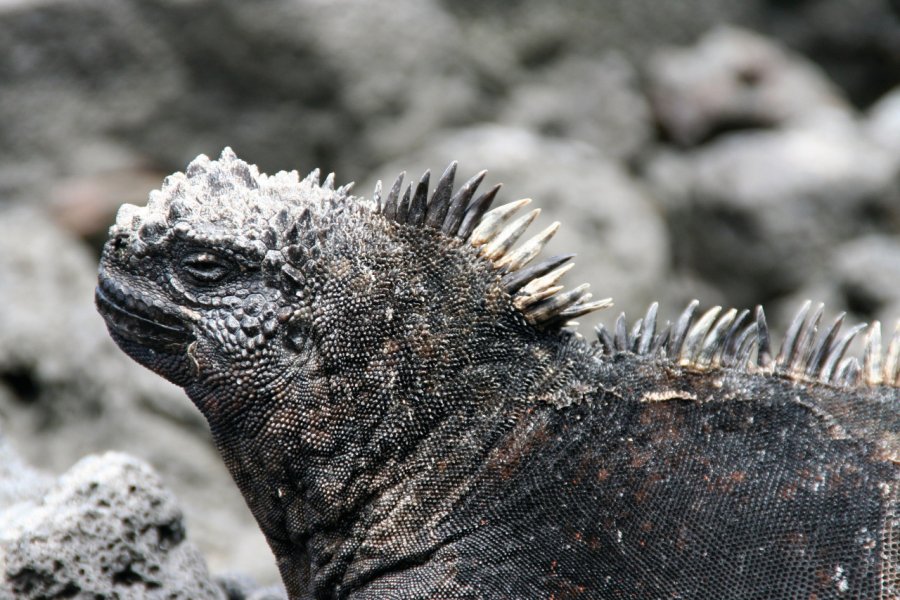Travel Guide Galápagos
Ten million years ago, erupting volcanoes created in the Pacific Ocean the amazing Colón archipelago, better known as Galapagos, nicknamed the "paradise of evolution" by Charles Darwin, and "last sanctuary of natural life" by Jacques-Yves Cousteau. Located in South America, on the equator line, about 1,000 km west of the American continent (at the level ofEcuador, the country to which the archipelago is attached), the 127 islands, islets and reefs that make up the archipelago, including 19 large islands and 4 inhabited ones, cover about 8,000 km². The Galapagos tourist guide will take you through its paradisiacal landscapes populated by an abundant and unique fauna: here, marine iguana, seal, giant tortoise, hammerhead shark and thousands of birds live together in a disconcerting harmony, without fearing the presence of man. From Isabela Island, the largest, and the small town of Puerto Villamil to the most eastern of them all, San Cristobal, passing through Santa Cruz Island, where Puerto Ayora is home to the largest population of the archipelago (6,000 inhabitants), one never ceases to be amazed by all the striking faces that the fauna and flora display here. It is not without reason that the Galapagos National Park and its marine reserve are the very first site to be listed as a UNESCO World Heritage Site in 1978. A must-see destination for nature lovers!
What to visit Galápagos?
When to go to Galápagos?
When to go to the Galapagos? To know when to go to the Galapagos, you have to keep in mind that the year is punctuated by the dry season - or garúa season - from the end of May to the end of December with a grey and overcast sky, coolness and drizzle on the heights, and the hot or rainy season which extends from the beginning of January to June with temperatures oscillating between 23°C and 32°C, a sunny sky, occasionally darkened by strong but scattered showers, a calm and warm sea (25°C). If, ten years ago, tourists were still rare in the archipelago, the situation has now changed and there is now a high tourist season that extends mainly over the months of July and August, but also at Christmas time and during the Holy Week for local tourism. The best time to go to the Galapagos is therefore around the months of February and March, May and June, but also from September to November.
Weather at the moment
The weather in Galapagos is subject to two seasons: the garúa season, which runs from June to December (rather overcast skies, coolness and drizzle on the heights, rough sea), and the warm season which starts at the beginning of January (sunny skies, occasionally darkened by heavy but scattered showers, a calm and warm sea). As far as temperatures are concerned, the Galapagos are rather well off, with a mercury around 23°C in the dry season and peaks of more than 30°C during the rainy season.
A stay in the Galapagos is not cheap! In addition to the 350 € of airfare from Ecuador to the archipelago, a week's stay in this little corner of paradise will cost you between 2 000 and 6 000 € depending on your lifestyle. It must be said that since the dollarization of the country, the cost of living has increased considerably. Nevertheless, the destination is worth its weight in gold. Tipping is not mandatory, but recommended if you are satisfied with a service.
For French, Belgian, Swiss and Canadian citizens, a valid passport valid for 6 months after your return will be required to visit the Galapagos and Ecuador in general. No visa is required for a tourist stay of 90 days or less. If the authorized stay is exceeded, the national may be placed in administrative detention in a temporary detention center. It is therefore recommended to respect the length of stay and, if necessary, to apply to the immigration service for an extension of the length of stay (citizens of the European Union, the United States or Canada can apply for a 12-X visa valid for 6 months without having to leave the country). Please note that the application must be made at least 30 days before the expiration of the stamp.
Taxes. The Galapagos entry tax is US$ 100 per person (US$ 50 for children under 12), plus US$ 20 airport tax.
To go to the Galapagos, and to Ecuador in general, the yellow fever vaccine is mandatory if you come from a country in America (or Africa) where the disease is present (Peru, Brazil, Bolivia...). In addition, vaccines against tetanus, diphtheria and hepatitis A (unless you are immune) are recommended. The more cautious and adventurous should add hepatitis B, rabies and typhoid fever. Plan your vaccinations several weeks before departure. Tap water is not drinkable in the Galapagos, prefer bottled water.
Practical information
- When to travel?
- Weather forecast
- Budget
- Formalities
- Health
- How to travel by yourself?
- How to get organized?
- Getting around
Media
How to go to Galápagos? Our advice & tips
Given the numerous islands to visit in the Galapagos archipelago, the idea of using the services of a travel agency is rather welcome. These specialists will be able to tailor a trip to your needs, depending on the time you have available and the areas you wish to visit first. The Galapagos Islands are ideal for all kinds of visits: family vacations, honeymooners, trekking or birdwatching trips, all-inclusive or not, as you wish!
Discover our selection of travel agencies for this destinationIt is entirely possible to visit the Galapagos Islands by making your own arrangements, and here, perhaps more than anywhere else, it is the anticipation that will save you money. A flight from Europe to the Galapagos Islands requires at least one stopover, whether in Quito or Guayaquil, and costs an average of €1,500. To get the best rates, it is essential to book well in advance. Same formula for the accommodation.
Inter-island transport. To travel between the islands, it is necessary to take boats or small planes (avionetas, emetebe company) providing domestic connections. Schedules and fluctuating rates. Find out more on the spot, in Puerto Ayora or San Cristóbal. By boat, count 30 US$ per person for a single trip.
Find unique holiday offers with our partners
Pictures and images Galápagos
Featured articles Galápagos
Other destinations Galápagos
- Puerto Villamil
- Puerto Baquerizo Moreno
- Playa Puerto Chino
- Roca León Dormido - Kicker'S Rock
- Puerto Ayora
- Isla Española - Hood
- Isla Lobos
- Punta Pitt
- Isla Fernandina - Narborough
- Isla Floreana - Santa María
- Playa Ochoa
- Isla Bartolomé
- Isla Genovesa - Tower
- Isla Daphne Mayor - Isla Daphne Menor
- El Junco
- El Progreso
- Isla Santa Fé - Barrington
- Isla Roca Redonda
- Isla Darwin - Culpepper
- Santo Tomás
- Isla Pinzón - Duncan
- Isla Santiago - San Salvador - James
- Isla Seymour Norte
- Isla Pinta - Abingdon
- Isla Plaza Sur
- Isla Rábida - Jervis
- Isla Baltra - Seymour Sur
- Isla Marchena - Bindloe
- Santa Rosa
- Isla Wolf - Wenman
